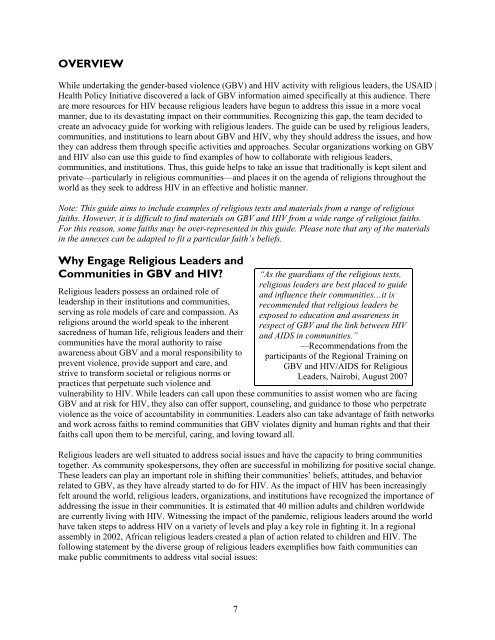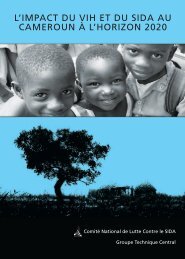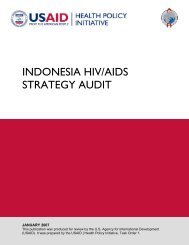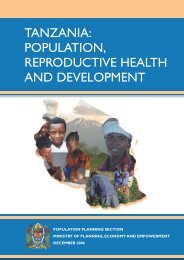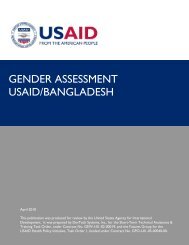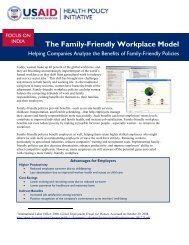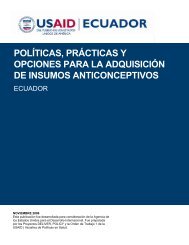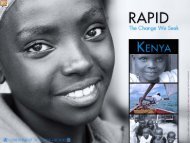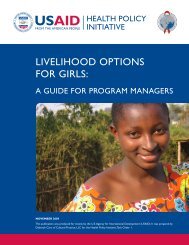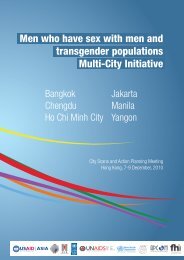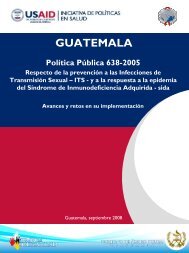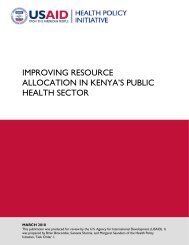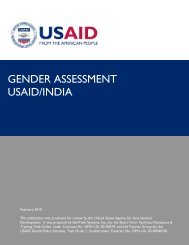A Call to Act - Health Policy Initiative
A Call to Act - Health Policy Initiative
A Call to Act - Health Policy Initiative
Create successful ePaper yourself
Turn your PDF publications into a flip-book with our unique Google optimized e-Paper software.
OVERVIEW<br />
While undertaking the gender-based violence (GBV) and HIV activity with religious leaders, the USAID |<br />
<strong>Health</strong> <strong>Policy</strong> <strong>Initiative</strong> discovered a lack of GBV information aimed specifically at this audience. There<br />
are more resources for HIV because religious leaders have begun <strong>to</strong> address this issue in a more vocal<br />
manner, due <strong>to</strong> its devastating impact on their communities. Recognizing this gap, the team decided <strong>to</strong><br />
create an advocacy guide for working with religious leaders. The guide can be used by religious leaders,<br />
communities, and institutions <strong>to</strong> learn about GBV and HIV, why they should address the issues, and how<br />
they can address them through specific activities and approaches. Secular organizations working on GBV<br />
and HIV also can use this guide <strong>to</strong> find examples of how <strong>to</strong> collaborate with religious leaders,<br />
communities, and institutions. Thus, this guide helps <strong>to</strong> take an issue that traditionally is kept silent and<br />
private—particularly in religious communities—and places it on the agenda of religions throughout the<br />
world as they seek <strong>to</strong> address HIV in an effective and holistic manner.<br />
Note: This guide aims <strong>to</strong> include examples of religious texts and materials from a range of religious<br />
faiths. However, it is difficult <strong>to</strong> find materials on GBV and HIV from a wide range of religious faiths.<br />
For this reason, some faiths may be over-represented in this guide. Please note that any of the materials<br />
in the annexes can be adapted <strong>to</strong> fit a particular faith’s beliefs.<br />
Why Engage Religious Leaders and<br />
Communities in GBV and HIV?<br />
Religious leaders possess an ordained role of<br />
leadership in their institutions and communities,<br />
serving as role models of care and compassion. As<br />
religions around the world speak <strong>to</strong> the inherent<br />
sacredness of human life, religious leaders and their<br />
communities have the moral authority <strong>to</strong> raise<br />
awareness about GBV and a moral responsibility <strong>to</strong><br />
prevent violence, provide support and care, and<br />
strive <strong>to</strong> transform societal or religious norms or<br />
practices that perpetuate such violence and<br />
“As the guardians of the religious texts,<br />
religious leaders are best placed <strong>to</strong> guide<br />
and influence their communities…it is<br />
recommended that religious leaders be<br />
exposed <strong>to</strong> education and awareness in<br />
respect of GBV and the link between HIV<br />
and AIDS in communities.”<br />
—Recommendations from the<br />
participants of the Regional Training on<br />
GBV and HIV/AIDS for Religious<br />
Leaders, Nairobi, August 2007<br />
vulnerability <strong>to</strong> HIV. While leaders can call upon these communities <strong>to</strong> assist women who are facing<br />
GBV and at risk for HIV, they also can offer support, counseling, and guidance <strong>to</strong> those who perpetrate<br />
violence as the voice of accountability in communities. Leaders also can take advantage of faith networks<br />
and work across faiths <strong>to</strong> remind communities that GBV violates dignity and human rights and that their<br />
faiths call upon them <strong>to</strong> be merciful, caring, and loving <strong>to</strong>ward all.<br />
Religious leaders are well situated <strong>to</strong> address social issues and have the capacity <strong>to</strong> bring communities<br />
<strong>to</strong>gether. As community spokespersons, they often are successful in mobilizing for positive social change.<br />
These leaders can play an important role in shifting their communities’ beliefs, attitudes, and behavior<br />
related <strong>to</strong> GBV, as they have already started <strong>to</strong> do for HIV. As the impact of HIV has been increasingly<br />
felt around the world, religious leaders, organizations, and institutions have recognized the importance of<br />
addressing the issue in their communities. It is estimated that 40 million adults and children worldwide<br />
are currently living with HIV. Witnessing the impact of the pandemic, religious leaders around the world<br />
have taken steps <strong>to</strong> address HIV on a variety of levels and play a key role in fighting it. In a regional<br />
assembly in 2002, African religious leaders created a plan of action related <strong>to</strong> children and HIV. The<br />
following statement by the diverse group of religious leaders exemplifies how faith communities can<br />
make public commitments <strong>to</strong> address vital social issues:<br />
7


